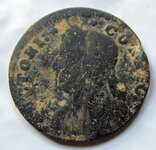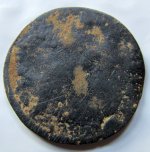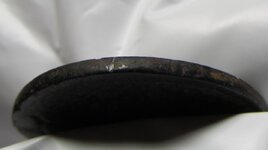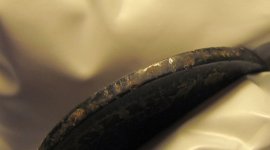Bramblefind
Silver Member
I went out this morning to a site I have been going to for years. It is really where I got my start detecting. On other digs I found a 1795 large cent and a whole bunch of nice buttons there. But it has been very quiet lately. I was there for nearly 2 hours and not finding much at all and decided to head back home.
I went to the old road and started walking up the side. It is also an area where I have dug many modern bullets etc. Since when the local farmers were teens they used to practice shooting there. I got a solid "zinc" signal and I thought ok here is a shotgun shell end to finish the day. This will be my last target.
I put the shovel in and flipped the dirt and out popped this! I couldn't believe it! Probably 2 inches down! I scanned it again just to be sure and once again it came up very low in the zinc range.
After showing it to some colonial coin experts there was a request made to nick the edge to see if any copper color would come through - I did a good scratch to it and it looks white. It also shows signs of being cast. Still inconclusive on what its origins might be - my gut since I first picked it up is that it is a counterfeit. But I haven't handled too many Connecticuts.
** I give up on getting the photos in the correct order**
I went to the old road and started walking up the side. It is also an area where I have dug many modern bullets etc. Since when the local farmers were teens they used to practice shooting there. I got a solid "zinc" signal and I thought ok here is a shotgun shell end to finish the day. This will be my last target.
I put the shovel in and flipped the dirt and out popped this! I couldn't believe it! Probably 2 inches down! I scanned it again just to be sure and once again it came up very low in the zinc range.
After showing it to some colonial coin experts there was a request made to nick the edge to see if any copper color would come through - I did a good scratch to it and it looks white. It also shows signs of being cast. Still inconclusive on what its origins might be - my gut since I first picked it up is that it is a counterfeit. But I haven't handled too many Connecticuts.
** I give up on getting the photos in the correct order**
Amazon Forum Fav 👍
Attachments
Last edited:
Upvote
1






 ?
? The damage to the coin really is minimal to the naked eye. It looks much brighter in the photo due to magnification and catching it with the lighting. I've studied and sold a number of old coins now and I am OK with this. Though I probably scratched it more than I needed to.
The damage to the coin really is minimal to the naked eye. It looks much brighter in the photo due to magnification and catching it with the lighting. I've studied and sold a number of old coins now and I am OK with this. Though I probably scratched it more than I needed to.

